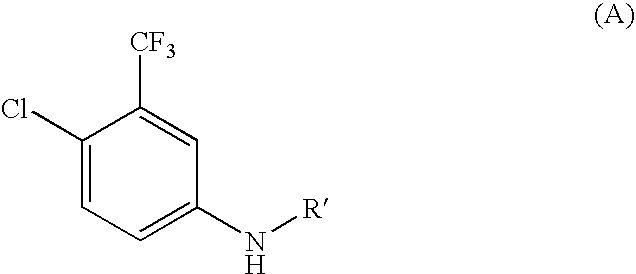Process for the Preparation of a RAF Kinase Inhibitor and Intermediates for Use in the Process
- Summary
- Abstract
- Description
- Claims
- Application Information
AI Technical Summary
Benefits of technology
Problems solved by technology
Method used
Image
Examples
example 1
Synthesis of phenyl 4-chloro-3-(trifluoromethyl)phenylcarbamate (Compound 2)
[0180]3-trifluoromethyl-4-chloroaniline (25 g, 0.1278 mol) and pyridine (26 ml, 0.3195 mol) were dissolved in dichloromethane (250 ml). The reaction mass was cooled to 0° C. to −5° C. and a solution of phenyl chloroformate (22 ml, 0.1661 mol) in dichloromethane (100 ml) was added drop wise maintaining the temperature of the reaction mass below 0° C. The reaction mass was stirred at 0° C. to 5° C. for 1-2 hours and quenched with water (200 ml) below 10° C. The organic phase was separated and washed with water followed by 1N HCl. It was then dried over sodium sulfate and concentrated to obtain solid. This solid was agitated with hexane (350 ml) at ambient temperature for 2-3 hours and filtered. The obtained product was vacuum dried at 50° C. to give phenyl 4-chloro-3-(trifluoromethyl)phenylcarbamate (36 g) as white solid.
example 2
Synthesis of 1-(4-chloro-3-(trifluoromethyl)phenyl)-3-(4-hydroxyphenyl)urea (Compound 1)
[0181]To the dry N,N-dimethyl formamide (150 ml) phenyl 4-chloro-3-(trifluoromethyl)phenylcarbamate (50 g, 0.15873 mol) and p-amino phenol (20.78 g, 0.1904 mol) were added at room temperature. The reaction mass was then heated to 50° C. for 4-6 hours and cooled to room temperature. Water (500 ml) was added and the obtained mass was extracted with ethyl acetate and the combined extracts were washed with water. It was dried over sodium sulfate and concentrated to obtain semi solid. The residue was then charged with acetonitrile (700 ml) and the obtained precipitate was stirred at ambient temperature for 2-3 hours. The solid was filtered and washed thoroughly with acetonitrile till clear filtrate was obtained. The solid thus obtained was dried in vacuum oven at 50° C. to afford the desired 1-(4-chloro-3-(trifluoromethyl)phenyl)-3-(4-hydroxyphenyl)urea (40 g).
example 3
Synthesis of 2,2,2-trichloro-N-(4-chloro-3-(trifluoromethyl)phenyl)acetamide (Compound 3)
[0182]The clear solution of 3-trifluoromethyl-4-chloroaniline (35 g, 0.1789 mol) and pyridine (36 ml, 0.447 mol) in dichloromethane (350 ml) was cooled at 0° C. to −5° C. and a solution of trichloro acetyl chloride (26 ml, 0.2326 mol) in dichloromethane (75 ml) was added drop wise maintaining temperature of the reaction mass below 0° C. The reaction mass was stirred for 1 hour below 0° C. and quenched with water (150 ml) below 5° C. The organic phase was separated and aqueous layer was reextracted with dichloromethane. The combined dichloromethane layer was then washed with water, dried over sodium sulfate and evaporated under vacuum to obtain (55 g) the desired product, i.e., 2,2,2-trichloro-N-(4-chloro-3-(trifluoromethyl)phenyl)acetamide.
PUM
| Property | Measurement | Unit |
|---|---|---|
| Current | aaaaa | aaaaa |
Abstract
Description
Claims
Application Information
 Login to View More
Login to View More - R&D
- Intellectual Property
- Life Sciences
- Materials
- Tech Scout
- Unparalleled Data Quality
- Higher Quality Content
- 60% Fewer Hallucinations
Browse by: Latest US Patents, China's latest patents, Technical Efficacy Thesaurus, Application Domain, Technology Topic, Popular Technical Reports.
© 2025 PatSnap. All rights reserved.Legal|Privacy policy|Modern Slavery Act Transparency Statement|Sitemap|About US| Contact US: help@patsnap.com



